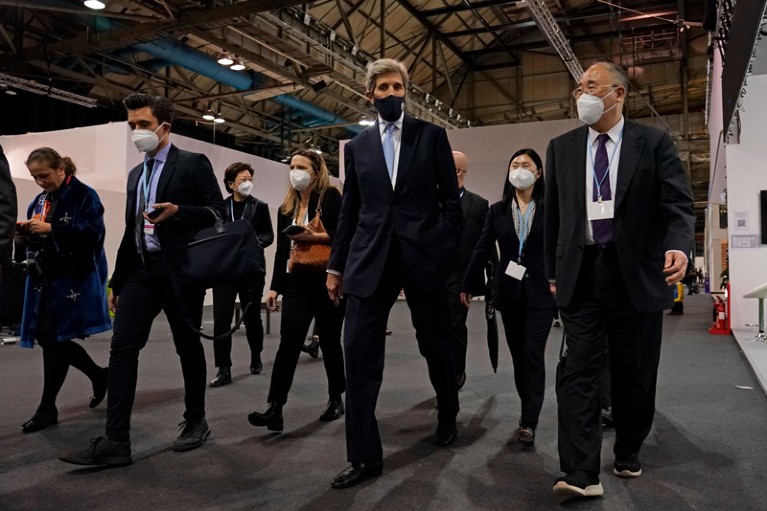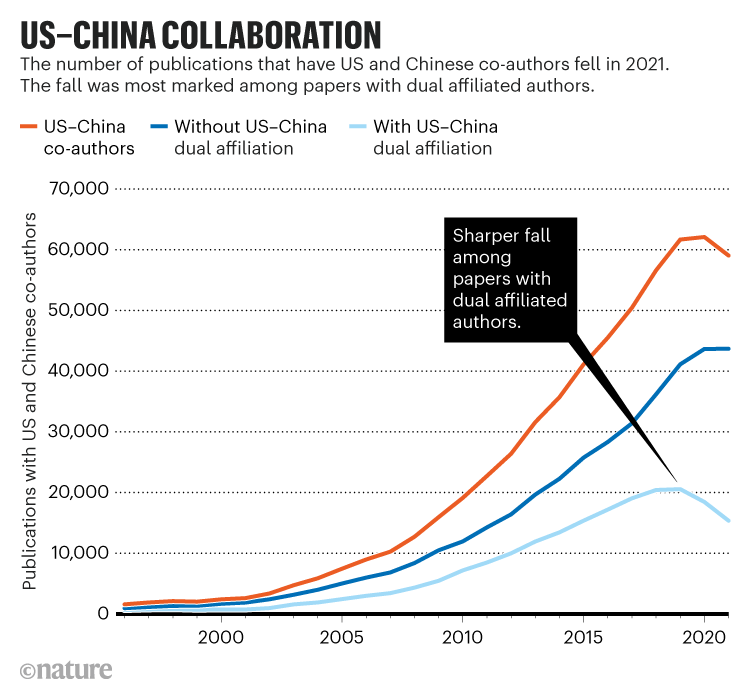[ad_1]

Climate envoys John Kerry of the United States and Xie Zhenhua of China at last year’s climate convention in Glasgow, UKCredit: Alberto Pezzali/AP/Shutterstock
Chinese President Xi Jinping, who has given himself a third five-year term as his country’s leader, has moved science to the front and centre of his presidency. At the Communist Party’s 20th congress in late October, he declared that China must “regard science and technology as our primary productive force, talent as our primary resource and innovation as our primary driver of growth”. To underscore this ambition, 6 of the 25 newly announced members of the decision-making Politburo have a science background. This compares with one in the previous iteration.
Science has flourished in Xi’s first decade in power. Furthermore, the past two decades have seen a welcome expansion of international collaborations, especially with researchers from the United States. Now that seems to be ending, in large part because of rising tensions between the two nations. This comes at a time when the world — especially future generations — desperately needs these two giants to work together.
China’s ascent in science and technology is remarkable. The seeds were planted 35 years ago, in the era of premier Deng Xiaoping, and the country now produces more research publications than any other. Its gross expenditure on research and development (R&D) has increased from 1.9% of gross domestic product to 2.4% in the past decade alone. China spent more than US$550 billion on R&D in 2020 (adjusted for purchasing power parity), double its 2012 expenditure. Between that and the $650-billion US R&D budget, the two countries currently spend more than half the world total of $1.7 trillion.
But after blooming in the early 2000s, China–US collaborations plateaued in 2020 and have been declining since (‘see Dual affiliations’), as Nature has previously reported. The COVID-19 pandemic is a factor for sure (especially China’s zero-COVID policy), but tensions between the two governments, as well as between China and the European Union, are another. These have been building for some years. As China continues on a path to becoming the world’s largest economy, the United States sees it as not only an economic threat, but also a military one — which China denies.

Source: J. Baas/Scopus (journal and conference papers, books, and review articles).
The administration of US President Joe Biden has ended its predecessor’s controversial and poorly thought-out China Initiative — a sweeping policy that penalized US academics for not disclosing work in or funding from China, and led to innocent people being targeted by law-enforcement agencies. In other respects, the United States continues to crack down on collaborations concerning digital technologies such as artificial intelligence (AI). Last month, the administration announced rules preventing US companies from exporting advanced computer chips capable of training AI algorithms to China.
China says it is engaged in cooperation and opposes confrontation. However, its defence spending is on a steep upward trajectory. At the same time, its leadership has been making signals that international collaboration is no longer a priority. In February 2020, the government announced changes to its research-evaluation policy that would mean researchers would no longer have extra incentives for publishing in international journals. This was reinforced in China’s latest five-year plan, last March.
The chill in relations extends beyond academic and industrial research. Last year, at the 26th Conference of the Parties to the United Nations Framework Convention on Climate Change in Glasgow, UK, climate envoys John Kerry of the United States and Xie Zhenhua of China announced to the world’s relief that their nations would cooperate to combat climate change. Yet, this August, China halted this collaboration.
What Xi Jinping’s third term means for science
Furthermore, China is chairing the next conference of the parties to the UN convention on biodiversity. The summit was meant to be held in Kunming later this year, but has been moved to Montreal, Canada, because of China’s zero-COVID policy. It is now unclear if world leaders will be invited. That is not the message the world needs from a summit at which a new set of targets and timetables must be agreed.
Biodiversity loss, climate change, infectious diseases and nuclear conflict are all transboundary threats. As Kerry told The Guardian newspaper last month, climate “does not represent global competition. It represents a global threat to the world, which the two largest emitters and two largest economies could greatly benefit the world by coming together and cooperating to try to deal with it.”
It is naive to think that science will not be affected by a wider chill in international relations. But when governments stop getting along, there is no need for barriers to slam down for everyone else. The United States and China need to discover (or rediscover) a language of cooperation that tackles international threats while still protecting their national interests. If anything, we have been here before. The nations involved in the cold war understood the necessity of research cooperation. To that end, they established the International Centre for Theoretical Physics in Trieste, Italy, and the International Institute for Applied Systems Analysis in Laxenburg, Austria, where scientists from East and West could openly collaborate — and still do.
The world of 2022 is both more interconnected and in a more precarious state than the world after 1945. We need superpowers to rise above the gathering storm and find creative ways to ensure that science’s hive mind can continue to hum as one.
[ad_2]
Source link


